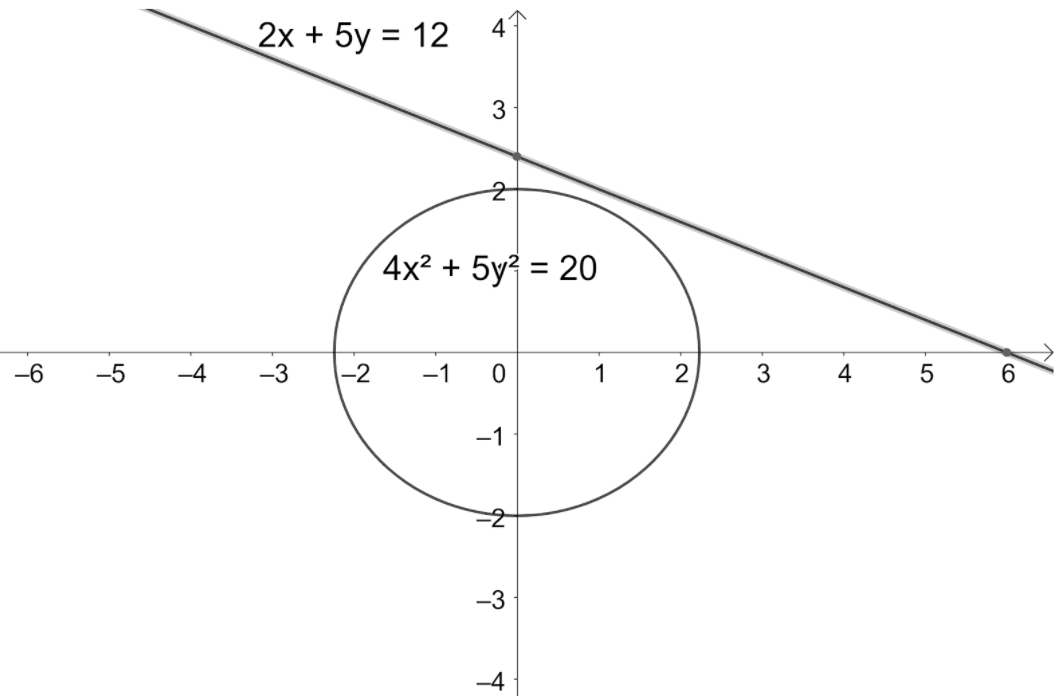
If the line $2x+5y=12$ intersects the ellipse $4{{x}^{2}}+5{{y}^{2}}=20$ in two distinct points A and B, then find the midpoint of AB?
(a) $\left( 0,1 \right)$
(b) $\left( 1,2 \right)$
(c) $\left( 1,0 \right)$
(d) $\left( 2,1 \right)$
Answer
556.8k+ views
Hint: We start solving the problem by assuming the points A and B using which we find the midpoint of the AB. We then substitute the equation of the line in the equation of the ellipse to get quadratic equations in ‘x’ and ‘y’. We then use the fact that the sum of the roots of the quadratic equation $a{{x}^{2}}+bx+c=0$ is $\dfrac{-b}{a}$ to get the coordinates of the mid-points of AB.
Complete step-by-step solution:
According to the problem, we are given that the line $2x+5y=12$ intersects the ellipse $4{{x}^{2}}+5{{y}^{2}}=20$ in two distinct points A and B. We need to find the midpoint of AB.
Let us assume the point A and B be $A\left( {{x}_{1}},{{y}_{1}} \right)$ and $B\left( {{x}_{2}},{{y}_{2}} \right)$.
So, the midpoint of A and B is $\left( \dfrac{{{x}_{1}}+{{x}_{2}}}{2},\dfrac{{{y}_{1}}+{{y}_{2}}}{2} \right)$ ---(1).

Now, we have the equation of the line $2x+5y=12$.
So, $2x=12-5y$.
$\Rightarrow x=6-\dfrac{5y}{2}$. Let us substitute this in $4{{x}^{2}}+5{{y}^{2}}=20$.
So, we get $4{{\left( 6-\dfrac{5y}{2} \right)}^{2}}+5{{y}^{2}}=20$.
$\Rightarrow 4\left( 36+\dfrac{25{{y}^{2}}}{4}-30y \right)+5{{y}^{2}}=20$.
$\Rightarrow 144+25{{y}^{2}}-120y+5{{y}^{2}}=20$.
$\Rightarrow 30{{y}^{2}}-120y+124=0$.
$\Rightarrow 15{{y}^{2}}-60y+62=0$.
The roots of this quadratic equation are the y-coordinates of the points of intersection of the line $2x+5y=12$ with the ellipse $4{{x}^{2}}+5{{y}^{2}}=20$.
This resembles the quadratic equation $a{{x}^{2}}+bx+c=0$, we know that the sum of the roots of this quadratic equation is $\dfrac{-b}{a}$.
So, we get ${{y}_{1}}+{{y}_{2}}=\dfrac{-\left( -60 \right)}{15}$.
$\Rightarrow {{y}_{1}}+{{y}_{2}}=\dfrac{60}{15}$.
$\Rightarrow {{y}_{1}}+{{y}_{2}}=4$.
$\Rightarrow \dfrac{{{y}_{1}}+{{y}_{2}}}{2}=2$ ---(2).
Now, we have the equation of the line $2x+5y=12$.
So, $5y=12-2x$.
$\Rightarrow y=\dfrac{12}{5}-\dfrac{2x}{5}$. Let us substitute this in $4{{x}^{2}}+5{{y}^{2}}=20$.
So, we get $4{{x}^{2}}+5{{\left( \dfrac{12}{5}-\dfrac{2x}{5} \right)}^{2}}=20$.
$\Rightarrow 4{{x}^{2}}+5\left( \dfrac{144}{25}+\dfrac{4{{x}^{2}}}{25}-\dfrac{48x}{25} \right)=20$.
$\Rightarrow 4{{x}^{2}}+\dfrac{144}{5}+\dfrac{4{{x}^{2}}}{5}-\dfrac{48x}{5}=20$.
$\Rightarrow \dfrac{24{{x}^{2}}}{5}+\dfrac{144}{5}-\dfrac{48x}{5}=20$.
$\Rightarrow 24{{x}^{2}}-48x+144=100$.
$\Rightarrow 24{{x}^{2}}-48x+44=0$.
$\Rightarrow 6{{x}^{2}}-12x+11=0$.
The roots of this quadratic equation are the x-coordinates of the points of intersection of the line $2x+5y=12$ with the ellipse $4{{x}^{2}}+5{{y}^{2}}=20$.
This resembles the quadratic equation $a{{x}^{2}}+bx+c=0$, we know that the sum of the roots of this quadratic equation is $\dfrac{-b}{a}$.
So, we get ${{x}_{1}}+{{x}_{2}}=\dfrac{-\left( -12 \right)}{6}$.
$\Rightarrow {{x}_{1}}+{{x}_{2}}=\dfrac{12}{6}$.
$\Rightarrow {{x}_{1}}+{{x}_{2}}=2$.
$\Rightarrow \dfrac{{{x}_{1}}+{{x}_{2}}}{2}=1$ ---(3).
Substituting equations (2) and (3) in equation (1), we get the midpoint of AB as $\left( 1,2 \right)$.
So, we have found the midpoint of AB as $\left( 1,2 \right)$.
The correct option for the given problem is (b).
Note: From the figure we can see that the line is not even touching the ellipse, which leads us to the points with coordinates as the complex numbers. We should know that the complex roots of the quadratic equation are distinct and the question didn’t mention that the points have to be real in this case. We can also solve this problem by substituting the options in the equation of the line to get the required option.
Complete step-by-step solution:
According to the problem, we are given that the line $2x+5y=12$ intersects the ellipse $4{{x}^{2}}+5{{y}^{2}}=20$ in two distinct points A and B. We need to find the midpoint of AB.
Let us assume the point A and B be $A\left( {{x}_{1}},{{y}_{1}} \right)$ and $B\left( {{x}_{2}},{{y}_{2}} \right)$.
So, the midpoint of A and B is $\left( \dfrac{{{x}_{1}}+{{x}_{2}}}{2},\dfrac{{{y}_{1}}+{{y}_{2}}}{2} \right)$ ---(1).

Now, we have the equation of the line $2x+5y=12$.
So, $2x=12-5y$.
$\Rightarrow x=6-\dfrac{5y}{2}$. Let us substitute this in $4{{x}^{2}}+5{{y}^{2}}=20$.
So, we get $4{{\left( 6-\dfrac{5y}{2} \right)}^{2}}+5{{y}^{2}}=20$.
$\Rightarrow 4\left( 36+\dfrac{25{{y}^{2}}}{4}-30y \right)+5{{y}^{2}}=20$.
$\Rightarrow 144+25{{y}^{2}}-120y+5{{y}^{2}}=20$.
$\Rightarrow 30{{y}^{2}}-120y+124=0$.
$\Rightarrow 15{{y}^{2}}-60y+62=0$.
The roots of this quadratic equation are the y-coordinates of the points of intersection of the line $2x+5y=12$ with the ellipse $4{{x}^{2}}+5{{y}^{2}}=20$.
This resembles the quadratic equation $a{{x}^{2}}+bx+c=0$, we know that the sum of the roots of this quadratic equation is $\dfrac{-b}{a}$.
So, we get ${{y}_{1}}+{{y}_{2}}=\dfrac{-\left( -60 \right)}{15}$.
$\Rightarrow {{y}_{1}}+{{y}_{2}}=\dfrac{60}{15}$.
$\Rightarrow {{y}_{1}}+{{y}_{2}}=4$.
$\Rightarrow \dfrac{{{y}_{1}}+{{y}_{2}}}{2}=2$ ---(2).
Now, we have the equation of the line $2x+5y=12$.
So, $5y=12-2x$.
$\Rightarrow y=\dfrac{12}{5}-\dfrac{2x}{5}$. Let us substitute this in $4{{x}^{2}}+5{{y}^{2}}=20$.
So, we get $4{{x}^{2}}+5{{\left( \dfrac{12}{5}-\dfrac{2x}{5} \right)}^{2}}=20$.
$\Rightarrow 4{{x}^{2}}+5\left( \dfrac{144}{25}+\dfrac{4{{x}^{2}}}{25}-\dfrac{48x}{25} \right)=20$.
$\Rightarrow 4{{x}^{2}}+\dfrac{144}{5}+\dfrac{4{{x}^{2}}}{5}-\dfrac{48x}{5}=20$.
$\Rightarrow \dfrac{24{{x}^{2}}}{5}+\dfrac{144}{5}-\dfrac{48x}{5}=20$.
$\Rightarrow 24{{x}^{2}}-48x+144=100$.
$\Rightarrow 24{{x}^{2}}-48x+44=0$.
$\Rightarrow 6{{x}^{2}}-12x+11=0$.
The roots of this quadratic equation are the x-coordinates of the points of intersection of the line $2x+5y=12$ with the ellipse $4{{x}^{2}}+5{{y}^{2}}=20$.
This resembles the quadratic equation $a{{x}^{2}}+bx+c=0$, we know that the sum of the roots of this quadratic equation is $\dfrac{-b}{a}$.
So, we get ${{x}_{1}}+{{x}_{2}}=\dfrac{-\left( -12 \right)}{6}$.
$\Rightarrow {{x}_{1}}+{{x}_{2}}=\dfrac{12}{6}$.
$\Rightarrow {{x}_{1}}+{{x}_{2}}=2$.
$\Rightarrow \dfrac{{{x}_{1}}+{{x}_{2}}}{2}=1$ ---(3).
Substituting equations (2) and (3) in equation (1), we get the midpoint of AB as $\left( 1,2 \right)$.
So, we have found the midpoint of AB as $\left( 1,2 \right)$.
The correct option for the given problem is (b).
Note: From the figure we can see that the line is not even touching the ellipse, which leads us to the points with coordinates as the complex numbers. We should know that the complex roots of the quadratic equation are distinct and the question didn’t mention that the points have to be real in this case. We can also solve this problem by substituting the options in the equation of the line to get the required option.
Recently Updated Pages
Why are manures considered better than fertilizers class 11 biology CBSE

Find the coordinates of the midpoint of the line segment class 11 maths CBSE

Distinguish between static friction limiting friction class 11 physics CBSE

The Chairman of the constituent Assembly was A Jawaharlal class 11 social science CBSE

The first National Commission on Labour NCL submitted class 11 social science CBSE

Number of all subshell of n + l 7 is A 4 B 5 C 6 D class 11 chemistry CBSE

Trending doubts
What is meant by exothermic and endothermic reactions class 11 chemistry CBSE

10 examples of friction in our daily life

One Metric ton is equal to kg A 10000 B 1000 C 100 class 11 physics CBSE

1 Quintal is equal to a 110 kg b 10 kg c 100kg d 1000 class 11 physics CBSE

Difference Between Prokaryotic Cells and Eukaryotic Cells

What are Quantum numbers Explain the quantum number class 11 chemistry CBSE




